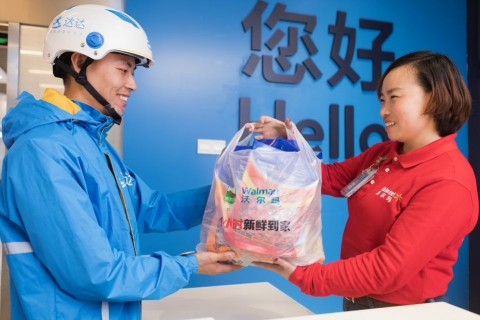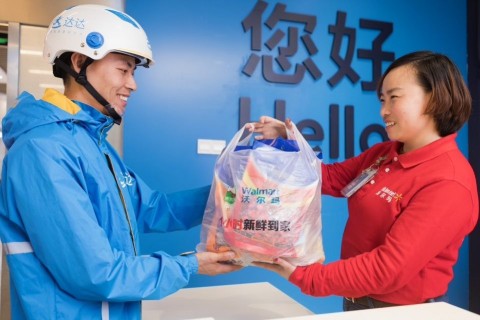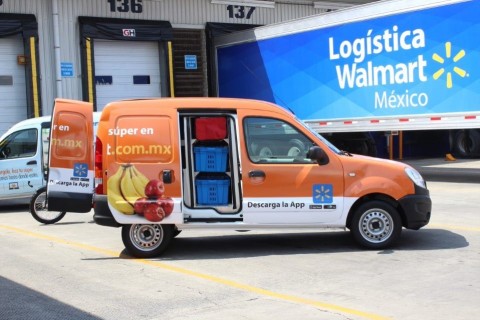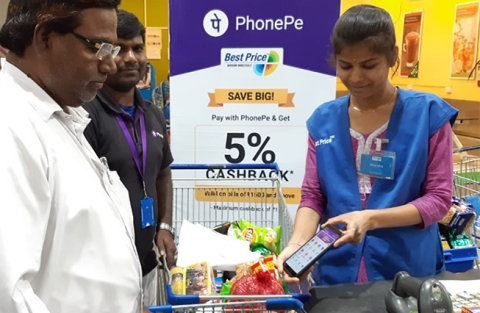BENTONVILLE, Ark.--(BUSINESS WIRE)--The grocery industry is a great example. American shoppers average about 60 minutes spent shopping for food each week. To cut this time down, more and more of Walmart’s U.S. customers find themselves taking advantage of online shopping options like pickup and delivery.
But the U.S. isn’t the only place customers want convenience. Walmart Canada’s recent announcement to expand grocery delivery with Instacart demonstrates how quickly customers are responding to time-saving innovations in markets across the globe.
“Customers around the world are kind of the same,” said JP Suarez, EVP and Chief Administration Officer for Walmart International. “They want quality, a great assortment, a great price, and they want it whenever they want it.”
While convenience is a shared desire, the solutions for delivering it are different in local markets. Here’s a look at how Walmart International is innovating when it comes to crossing the last mile – getting items even closer to their final destination.
A Shared Priority
In some cases, grocery delivery isn’t just easier – it’s life-changing. At age 81, Ana Luis de Anda Cortes has a prosthetic leg and can’t drive. This means ordering from her local Superama store in Mexico City is a service she relies on.
Superama has offered grocery delivery since 1991, and today the brand delivers an extended assortment nationwide. In fact, customers in Mexico are so accustomed to grocery delivery, it’s common for them to visit the store and ask if associates can take their shopping baskets to their homes.
Across Mexico, a mixture of owned delivery vehicles and delivery partners allows Walmart’s many formats to deliver to customers almost anywhere. But Mexico isn’t the only market with such a broad reach. South Africa’s Massmart also uses a network of third-party and owned vehicles, including crowdsourced provider Wumdrop, which operates in 16 Makro stores in Cape Town, Johannesburg, Pretoria and Durban to deliver to its customers.
Many markets are adding services rapidly, so more customers can experience added convenience. Argentina added 2,000 bikers – many with special, sustainable tricycles – in 2018 to serve the larger Buenos Aires area. Chile is adding pickup services to stores around the country at a rapid rate including the recent addition of a southernmost location in Punta Arenas. And, customers are responding – 60% of all Chilean online orders are for pickup. Meanwhile in Central America, the race is on as Guatemala begins testing pickup in stores with plans to expand to the rest of the region.
As pickup and delivery services become more commonplace, markets are finding additional, creative ways to offer convenience. In Canada, Walmart and PenguinPickUp launched co-branded locations in urban areas, making grocery shopping easier with pickup stations conveniently located for customers who are several miles from a Supercentre.
Speeding Up Delivery
In the Chinese cities of Shenzhen, Shanghai and Chengdu, customers can expect lightning-fast, one-hour grocery deliveries. Recently, Walmart China completed a delivery in under nine minutes from the moment the order was placed until the product was at the customer’s door.
Walmart China works with the logistics team at Dada-JD Daojia to offer the speedy delivery service, which transports groceries directly from a warehouse-like depot system to customers’ doors. As of January 2019, Walmart China operated more than 30 depots with additional locations on the way.
ASDA in the United Kingdom is stepping up its delivery pace by launching same-day delivery to over 270 stores. But, the team isn’t stopping there. The British retailer is testing a service in partnership with Just Eat that delivers 100 essential products in 30 minutes or less.
Over in Japan, the Seiyu team is following these leads by piloting one-hour premium delivery this year. But that’s not what’s making headlines. This summer, customers visiting popular tourist spot Sarushima Island in Tokyo Bay will be able to have food and other fresh products flown in by a drone. The test program is the result of a partnership between Seiyu and Rakuten.
These services illustrate the power of great ideas generated by local markets.
“When we’re doing our job well, it means making it really easy for markets to move fast,” Suarez said. “We can connect them and accelerate, and then, get out of the way.”
Innovating in India
At its core, retail innovation is focused on a simple goal: finding the solution that makes the most sense for customers.
In many respects, the Indian market is unique.
In rural India, small stores called kiranas are a major part of how many customers get their groceries. Like many small business owners, they buy products wholesale, so they can keep their costs low. But, many wholesalers don’t offer online payments, which pushes business owners to make a special trip to their banks for cash. The time spent at the bank can mean interrupted service back at the store, as many kiranas have to close their shops to stand in line and make a withdrawal.
Earlier this year, Walmart India announced that it was adding the PhonePe payment method, allowing over 1 million members of Best Price’s B2B Cash and Carry wholesale stores to pay for purchases via their phones.
To those not familiar with India’s challenges, this may not look like cutting-edge progress, but it’s a creative solution in the global journey toward a digital economy. This new mobile payment system goes the extra mile in allowing kiranas to purchase items without having to leave their stores, so a broader network of customers has the opportunity to get what they need with uninterrupted service.
“The small shops are really important to us in India,” Suarez said. “Through them, we can get into communities we wouldn’t be able to otherwise.”
Innovative projects like these give Suarez a lot of optimism for the future.
“The market teams are excelling at finding ways to make life easier for our customers. That’s what’s really brilliant about our last mile services around the world,” he said.








